Discover our
Home for Learning
- Contact
- 412-624-8020
- [email protected]
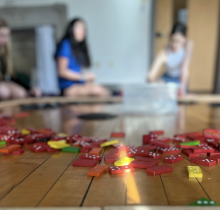
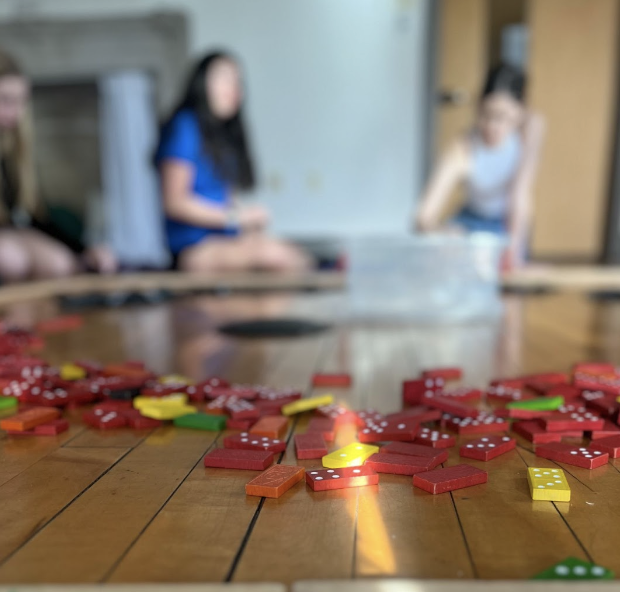
For the past couple of years I have been exploring the process of building chains of dominoes with kids and adults. The activity has always left me with lots of questions and ideas and epiphanies. The basic idea is to give the participants a bunch of blocks or dominoes and then challenge them to build a chain together. You can give them a starting point and an ending point or not. You can give them a time limit or not. You can do it as a whole group or in small groups. You can really do anything. Most of the progression of this activity comes from trying it first and making careful observations of the students. What are they doing, what are they saying? It's hard to predict what’s going to happen each time with each different group. And maybe that’s what excites me about doing this activity. It has a simple premise but unlimited possibilities. Watching a group of people explore this activity is absolutely fascinating. You see so many things. People working together, frustration, focus, patience, quiet, loud, laughter, blame, anger, joy and so much more.
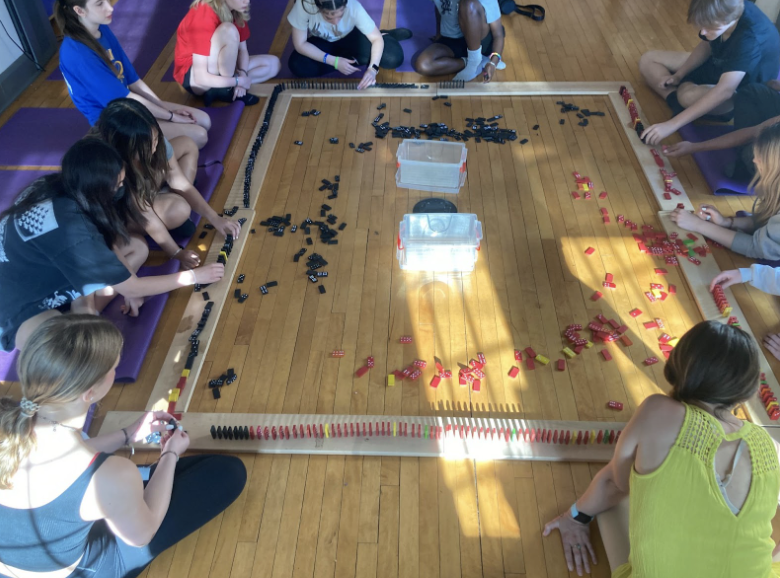
I have been doing this activity for a couple of years with many different students of all ages. I started to find a focus as to why you have people do something like this. I typically do this activity with my 1st and 2nd graders. And we are able to do this over and over and iterate and communicate and become more fluent with the concept of building something together. The kids get pretty excited about doing this activity and it's fun to think of different ways to challenge them. Maybe we are building in a circle. Maybe in a line. Maybe you are by someone you work well with. Maybe you’re not. There might be absolute freedom to build whatever you want for as long as you want. Or, you are given a time limit and only a certain path to build on. And it's this idea of a path that leads to the idea of this domino activity being something that could be a truly mindful experience.
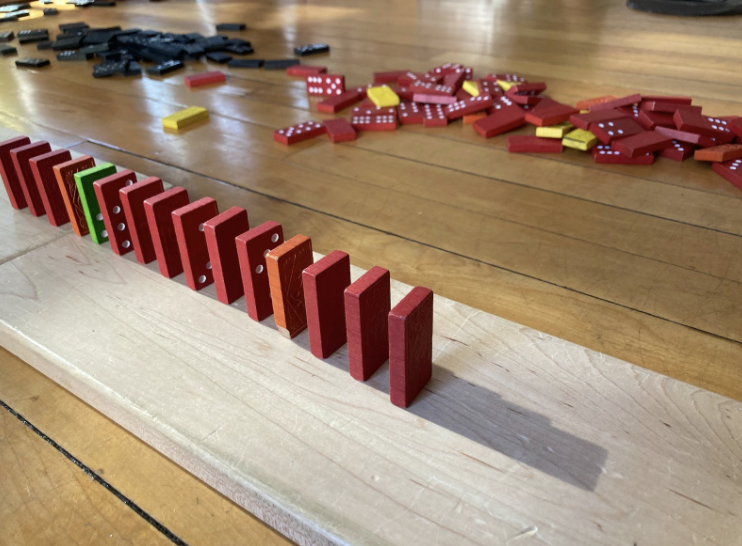
I knew there was a lot going on in everyone’s minds and bodies as they worked with the dominoes. I reflected a lot on how I felt as I worked. I had to really be mindful of the position of my body and the space around me. I had to be mindful of how much I talked. I had to be mindful of how much I listened. To be successful in building I really needed to be focused on the task and nothing else. That is another important thing about this activity. The teacher can insert themselves directly into the activity as a participant and fully feel the same things that their students are feeling. You can truly connect with your students when you do this. You are all feeling anxious at the same time. And you are all feeling relief when the chain is finished. All these themes of focus and quiet and mindfulness and reflection and noticing made me think of something.
The word mindfulness comes up a lot at the Falk Lab School. It is something we have been practicing for almost 100 years. I have had the privilege of learning from many teachers about how being mindful of the spaces, the materials and the people around us can truly form an amazing learning space. My colleague Chelsea was my partner teacher when this exploration of dominoes really took off and since then she has taken the role as our school’s yoga instructor. As someone who studies mindfulness and understands the importance of focus it just made sense to try something new with dominoes in her space in the school. The creation of “mindful dominoes” was beginning to take shape.
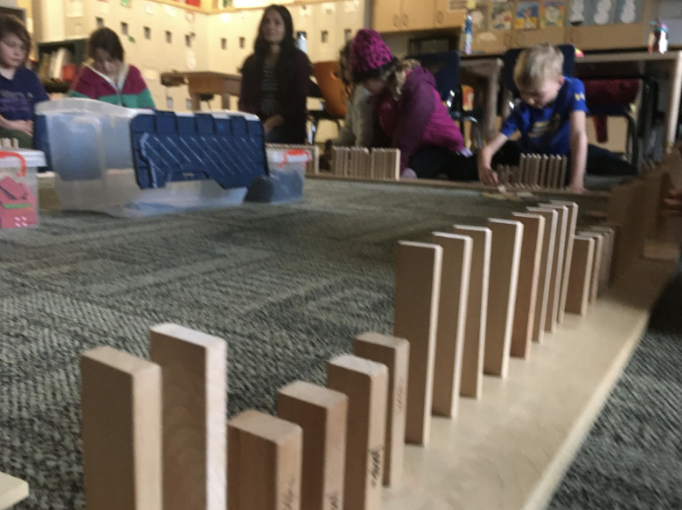 And here is the origin of mindful dominoes. I have known about the idea of practicing mindfulness and experiencing feelings through activities I started working at Falk. Our former yoga instructor, Ms. Northrop would lead amazing experiences for the entire faculty all the time. My favorite was the idea of passing an object around a circle of people but the challenge was that everyone’s eyes were closed. That experience stuck with me. And I have been doing that with my kids ever since. The feeling of being in a circle is powerful enough for a classroom. Then coupling that with a challenge that forces you to focus and feel nervous and also relieved when your turn is over is genius. This safe way of experiencing anxiety was so interesting to me. I start this activity by having the kids pass around these cute ceramic dinosaurs (at this point they know that I love dinosaurs). They are particularly careful with this object as it has importance to their teacher. The room gets quiet. Breathes are held. This tiny object makes its way around the room and a collective sigh of relief is let out. We reflect on our feelings.
And here is the origin of mindful dominoes. I have known about the idea of practicing mindfulness and experiencing feelings through activities I started working at Falk. Our former yoga instructor, Ms. Northrop would lead amazing experiences for the entire faculty all the time. My favorite was the idea of passing an object around a circle of people but the challenge was that everyone’s eyes were closed. That experience stuck with me. And I have been doing that with my kids ever since. The feeling of being in a circle is powerful enough for a classroom. Then coupling that with a challenge that forces you to focus and feel nervous and also relieved when your turn is over is genius. This safe way of experiencing anxiety was so interesting to me. I start this activity by having the kids pass around these cute ceramic dinosaurs (at this point they know that I love dinosaurs). They are particularly careful with this object as it has importance to their teacher. The room gets quiet. Breathes are held. This tiny object makes its way around the room and a collective sigh of relief is let out. We reflect on our feelings.
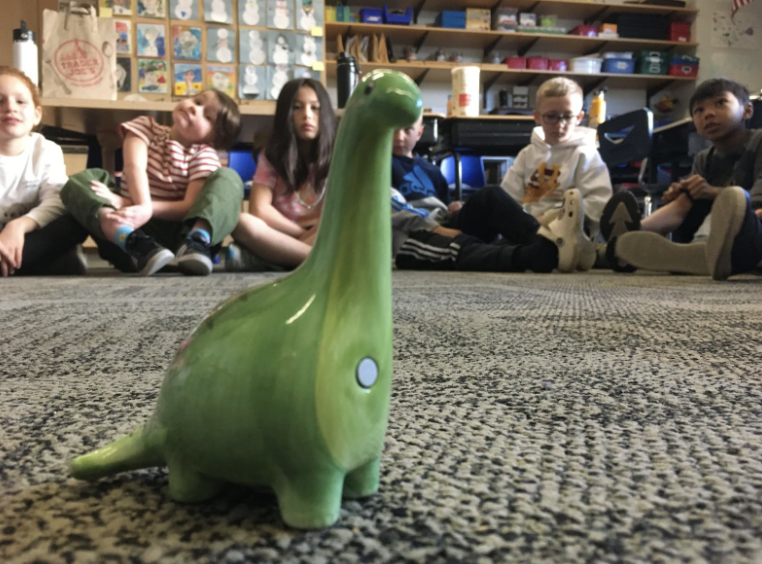
The magic has happened. What’s next?
Passing around ceramic dinos is all said and good, but what if you can up that challenge? Give the kids a glass of water and have them pass that around. Just listen and get ready to have your classroom be as quiet as it ever has been. I had kids comment on how weird it sounded to have the room be so quiet. The kids slow down, they focus, they grow quiet…and they feel so relieved when it's over and the glass still has most of its water still in it. Kids enjoy a good challenge and this type of activity connects them together through a shared experience. You are connecting to your neighbor in a visceral way. You have a shared goal of not spilling the water and shared feelings of anxiety and relief. And to go further, you as the teacher need to participate as well. Put yourself into the shoes of the kids and really feel what’s going on in the room. Magic happens when you do an activity like this.
The kids adored these activities and I am glad that I got to learn some new techniques on teaching this from my friend Chelsea. I typically barrel through my day with the kids. There is a nonstop sense of action in the classroom. We just go from one thing to the next without really stopping. That’s all said and good, but it's not the right environment for everyone. I love learning these mindful activities and sharing them with my class as a way to slow all of us down; myself included. I like seeing and hearing and feeling the room transform into a quiet state as we work on connecting with each other through a shared experience. The more I reflected the more I realized that these same feelings and goals come up in an activity I was already exploring on a very deep basis. Dominoes could transform into a more mindful experience.
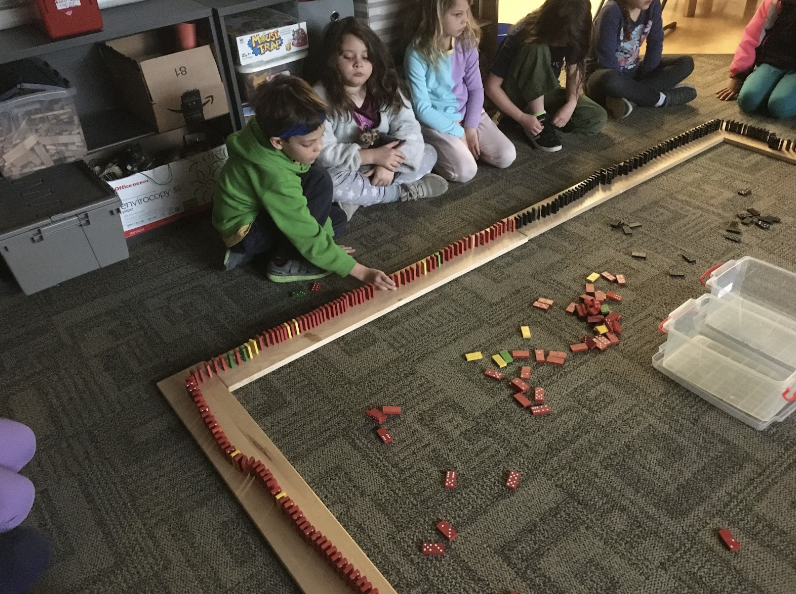 I started to connect the passing game with dominoes. I wanted to recreate that same feeling with a new activity. What I started with was forming a path. The dominoes would be given a path to be built on using some long wooden boards from our block area in the hallway. The path is really important. Just giving kids dominoes to play and explore with is really fun but they need to be given a space to build to create a more mindful environment. Just like the “pass the cup” experience the kids would need a path to move along and a way to really connect with everyone in the space. The wooden path really connected everyone and it provided focus too. I don’t like to be too prescriptive in my teaching, but I have come to understand that some mindfulness activities require focus and focus requires certain parameters. The wooden path gives you a reason to tell the kids to simply build a single path of dominoes. That simplicity is key too.
I started to connect the passing game with dominoes. I wanted to recreate that same feeling with a new activity. What I started with was forming a path. The dominoes would be given a path to be built on using some long wooden boards from our block area in the hallway. The path is really important. Just giving kids dominoes to play and explore with is really fun but they need to be given a space to build to create a more mindful environment. Just like the “pass the cup” experience the kids would need a path to move along and a way to really connect with everyone in the space. The wooden path really connected everyone and it provided focus too. I don’t like to be too prescriptive in my teaching, but I have come to understand that some mindfulness activities require focus and focus requires certain parameters. The wooden path gives you a reason to tell the kids to simply build a single path of dominoes. That simplicity is key too.
You give people dominoes to play with and what do they typically do? They tend to try and build really elaborate things. If you look up “domino chains” online you inevitably find videos that cease to amaze with the amount of complex building and amount of dominoes. It's honestly staggering to think about how anyone could build something like that. The challenge for some people is to keep it simple. There is a real struggle that happens when you tell someone to “keep it simple.” I think that they take that as a challenge to make it complicated. But in making it complicated you also make the chain fall down. It happens pretty much every time. Someone tries to get fancy and either their section doesn’t work or they knock over the chain before it is done or (and this might be the most interesting one) they cause people who kept it simple to get impatient and then they start talking or moving and then stuff starts to fall apart. A lesson where the idea of “keeping it simple” is the real challenge is so interesting to me and it provides some amazing moments to truly assess. It gives you a clear glimpse into the minds of the participants. Simplicity can be a hard thing to accept but this activity provides tangible evidence to allow people to understand that complexity doesn’t always equal better. Sometimes the simplest thing can be the most important.
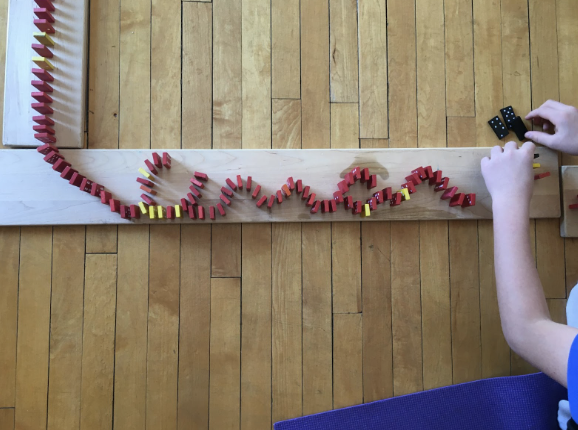 It has been a joy to discover a new way to teach this activity. And in making it more mindful and simple it has become something that really anyone can do in their spaces. My classroom worked it into our morning routine to do a few times a week to just get us in a quiet, focused space before starting our day. As well as building community by creating something together and sharing the frustration and joy that comes from building with dominoes. Our counselor, Ms. Stull, experimented with doing this on her own with our 5th grade classes. And I was given the chance to bring this to our yoga studio for a week to try it with the 8th graders. I know these kids are going to go through a very big transition when they leave our school to go to high school and I was curious if those feelings would make themselves present as they did this activity. Honestly, the kids just wanted to play with the dominoes at first (which is actually an important step in introducing any new material, give kids a chance to play a bit). The challenge saw many different and similar results. I gave advice on focus on body posture, but you really don’t want to “teach” too much when it comes to mindful dominoes. Let the materials and the participants create a space full of emotions. The kids were mostly successful in building the dominoes. They expressed lots of very similar feelings; frustration, stress, anxiety, relief, joy, surprise, calm, quiet, etc. Within the span of ten minutes we experience all these emotions and create something together. And then, for a fleeting moment, we quietly watch it all topple over. It was interesting to hear how quiet the 8th graders got when we knocked over the first domino and how quiet they stayed while the chain fell in that clink, clink, clink sound around the room.
It has been a joy to discover a new way to teach this activity. And in making it more mindful and simple it has become something that really anyone can do in their spaces. My classroom worked it into our morning routine to do a few times a week to just get us in a quiet, focused space before starting our day. As well as building community by creating something together and sharing the frustration and joy that comes from building with dominoes. Our counselor, Ms. Stull, experimented with doing this on her own with our 5th grade classes. And I was given the chance to bring this to our yoga studio for a week to try it with the 8th graders. I know these kids are going to go through a very big transition when they leave our school to go to high school and I was curious if those feelings would make themselves present as they did this activity. Honestly, the kids just wanted to play with the dominoes at first (which is actually an important step in introducing any new material, give kids a chance to play a bit). The challenge saw many different and similar results. I gave advice on focus on body posture, but you really don’t want to “teach” too much when it comes to mindful dominoes. Let the materials and the participants create a space full of emotions. The kids were mostly successful in building the dominoes. They expressed lots of very similar feelings; frustration, stress, anxiety, relief, joy, surprise, calm, quiet, etc. Within the span of ten minutes we experience all these emotions and create something together. And then, for a fleeting moment, we quietly watch it all topple over. It was interesting to hear how quiet the 8th graders got when we knocked over the first domino and how quiet they stayed while the chain fell in that clink, clink, clink sound around the room.
 It is actually hard to end this reflection. There is something about teaching using dominoes that never seems to have a clear ending. Every time you do this activity you learn something new. You learn things about your students. You learn things about yourself. There is something to be said about an activity that’s goal is to set something up that will inevitably fall over and lead you to wanting to set it up again. And when you do it as a group (no matter the age level or experience) you start to experience things together that are truly binding. You share frustrations and quiet moments. You share a goal. You share the failures. You share each other. You work to build a mindful space that works for all of you to accomplish the seemingly simple goal of setting up some tiny dominoes in a rectangle. And maybe that’s all it is. Set them up and knock them down. But do this activity in your classroom and see if that’s the case. But make sure you join the students. And try to be truly mindful of all the things going on around you; while trying to not knock over the dominoes you are currently setting up. And be sure to take a sigh of relief with your students once the whole thing is set up. Take that moment to feel connected. Then have someone knock over the first block and see what happens…together.
It is actually hard to end this reflection. There is something about teaching using dominoes that never seems to have a clear ending. Every time you do this activity you learn something new. You learn things about your students. You learn things about yourself. There is something to be said about an activity that’s goal is to set something up that will inevitably fall over and lead you to wanting to set it up again. And when you do it as a group (no matter the age level or experience) you start to experience things together that are truly binding. You share frustrations and quiet moments. You share a goal. You share the failures. You share each other. You work to build a mindful space that works for all of you to accomplish the seemingly simple goal of setting up some tiny dominoes in a rectangle. And maybe that’s all it is. Set them up and knock them down. But do this activity in your classroom and see if that’s the case. But make sure you join the students. And try to be truly mindful of all the things going on around you; while trying to not knock over the dominoes you are currently setting up. And be sure to take a sigh of relief with your students once the whole thing is set up. Take that moment to feel connected. Then have someone knock over the first block and see what happens…together.

Kevin Goodwin has worked at the Children’s Museum of Pittsburgh for the past several years in the Education/Learning and Research Department. He has worked in both traditional classroom settings as well as informal learning environments. Kevin has a Master’s in Early Childhood Education from Carlow University, a Bachelor's in Political Science from St. Bonaventure University, and is a member of the Harvard based Agency by Design research group located here in Pittsburgh. Kevin loves teaching children and considers himself a life-long learner. He also loves dinosaurs and sloths.
